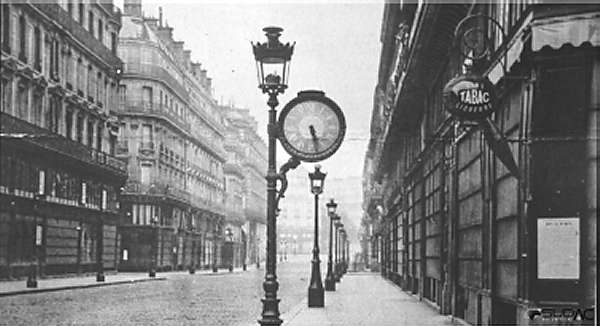A middle-class Parisian living around the turn of the twentieth century would have to budget for services like not just water or gas, but also time. Though electric clocks had been demonstrated, they were still a high-tech rarity; installing one in the home would have been completely out of the question. If you wanted to synchronize timekeeping across an entire major city, it made more sense to use a proven, reliable, and much cheaper infrastructure: pipes full of compressed air. Paris’ pneumatic postal system had been in service since 1866, and in 1877, Vienna had demonstrated that the same basic technology could be used to run clocks.
“The idea was to have a master clock in the center of Paris that would send out a pulse each minute to synchronize every clock around the city,” writes Ewan Cunningham at Primal Nebula, on a companion page to the Primal Space video above.
“The clocks wouldn’t have to be powered, the bursts of air would simply move all the clocks in the system forward at the same time. As for the master clock itself, it was kept in time by “another super accurate clock that was updated daily using observations of stars and planets” at the Paris Observatory. Just five years after its first implementation in 1880, this system had made possible the installation of thousands of “Popp clocks” (named for its Austrian inventor Victor Popp) in “hotels, train stations, houses, schools and public streets.”

In 1881, the visiting engineer Jules Albert Berly wrote of these “numerous clocks standing on graceful light iron pillars in the squares, at the corners of streets, and in other conspicuous positions about the city,” also noting those “throughout their hotels were, what is unusual with hotel clocks, keeping accurate time.” Apart from the great flood of 1910, which “stopped time” across Paris, this pneumatic time-keeping system seems to have remained in steady service for nearly half a century, until its discontinuation in 1927. But even now, nearly a century late, some of the sites where Popp clocks once stood are still identifiable — and thus worthy sites of pilgrimage for steampunk fans everywhere.
Related Content:
Paris Had a Moving Sidewalk in 1900, and a Thomas Edison Film Captured It in Action
How Big Ben Works: A Detailed Look Inside London’s Beloved Victorian Clock Tower
Clocks Around the World: How Other Languages Tell Time
How Clocks Changed Humanity Forever, Making Us Masters and Slaves of Time
Based in Seoul, Colin Marshall writes and broadcasts on cities, language, and culture. His projects include the Substack newsletter Books on Cities and the book The Stateless City: a Walk through 21st-Century Los Angeles. Follow him on Twitter at @colinmarshall or on Facebook.


Thanks for this! I have always been fascinated by horology, I disassembled my first alarm clock at age 6 or 7 and put it back together so well my parents did not notice.
I had a question for you, how did they resynch the clocks after the outage? Did they have to manually visit every subscriber or did they wait for the time of ten minutes to 11 to send the first pressure pulse?
It is not like the atomic clock signal from, I guess some version of WWV in Colorado that my Oregon Scientific atomic clocks receive. I just replaced my batteries in one last night before bed and voila this morning, day, date, time were all back to normal.
Again, thanks for this!
Peter Duffy, Los Angeles, CA
Note that the pneumatic system between Paris post offices remained in service until 1984 (mainly for distribution of telegrams as it was notoriously difficult to get a phone line throughout the 70s). ref: https://en.wikipedia.org/wiki/Paris_pneumatic_post
Protip: if something actually ‑was- created in the 19th century, it’s not “Steampunk.” It’s just history.